Summary: How to fix video quality? With the right video quality enhancer, you can quickly fix and enhance video quality to give your video a stunningly new look. Below, we have compiled a full tutorial explaining how to enhance video quality with the top 11 video enhancement software and apps.
Looking to elevate the quality of your videos? As a content creator, videographer, or someone looking to enhance personal footage, a video quality enhancer can transform your videos into visually stunning masterpieces. These powerful tools use advanced algorithms to sharpen details, improve color accuracy, reduce noise, and upscale resolution, giving your videos a polished, professional look. With so many options available, it can be tricky to find the right one. In this guide, we have compiled a full tutorial showing how to fix video quality with the best 11 video quality enhancer software and apps on any device. Whether you're after step-by-step guidance for improving video quality or searching for free enhancement solutions, this guide has everything you need!
- How to Enhance Video Quality on Windows/Mac (6 Ways)
- 1. VideoProc Converter AI 👍
- 2. Topaz Video Enhance AI
- 3. Adobe Premiere Pro
- 4. After Effects
- 5. Final Cut Pro X
- 6. Blender
- How to Enhance Video Quality Online (2 Ways)
- How to Enhance Video Quality on iPhone/Android (3 Ways)
- Video Quality Enhancer Comparison Chart
- Pre-Production Tips for Better Video Quality
- Post-Production Tips to Fix Video Quality
- FAQs
How to Enhance Video Quality on Windows/Mac
The most effective way to improve video quality is to utilize desktop video quality enhancer software. Video files are typically large in size and improving their quality often results in even larger file sizes. Video enhancing software generally offers more stable performance and larger storage space, minimizing the risk of crashes and data loss while fixing video quality. Additionally, a computer with a larger screen and sharper graphics can better display the resulting video. Here we have curated the 6 best video enhancement software that could increase video resolution to 1080p/4K, with detailed how-tos included.
1. VideoProc Converter AI
📌 Overall best AI video quality enhancer to improve video quality to 1080p/4K
📌 Operating System: Windows 7 and later, Mac 10.13 and later (for CoreML hardware acceleration); for Super Resolution, DirectML hardware acceleration (DirectX v12.0 or higher) is suggested for Windows
📌 Important Update: The latest V8.0 version has upgraded the performance of Super Resolution (V3 models), specifically, improved the AI video enhancing speed by 40%-80%.
As the best video quality enhancer, VideoProc Converter AI uses Super Resolution to enhance videos and images by 200%, 300%, or 400%. It can seamlessly increase the quality of 360p videos to the pristine standards of HD/4K while keeping as many details as possible without causing any frame loss, color distortion, artifact, or flickering effect.
Whether sourced from VHS tapes, mini DVs, Hi-8, DVDs, or low-resolution videos from CCTV or online downloads, the best AI video enhancer adeptly upscales and enhances them, rendering them suitable for modern viewing. Its latest update boasts enhanced AI upscaling models and quality/speed modes, significantly improving speed and enabling advanced capabilities such as denoising, deblurring, upscaling, and intricate detail generation. This greatly improves clarity, enriches details in aging or low-quality footage and images, and enhances features like skin texture, hair sharpness, fabric clarity, and natural textures, ensuring an immersive viewing experience like never before.
AIn addition to its ability to upscale and enhance low-quality videos, the best AI upscaling video software also integrates AI stabilization and Frame Interpolation tools. These features effortlessly handle videos featuring complex pictures and details, vibrant colors, and dynamic, high-motion content such as high-speed sports or game footage at high frame rates.
VideoProc Converter AI is impressively lightweight and places minimal demands on your hardware resources. It offers real-time Super Resolution capabilities and dynamically adapts the GPU memory usage to optimize efficiency, ensuring a seamless and efficient AI video upscaling performance.
Price: Free; Price packages start at $39.95
Features:
- The best video quality enhancer to fix and enhance video quality.
- Use the latest AI upscaling models to enhance the quality of highly-compressed videos, improving low resolution video to 1080p/4K.
- Smoothly enhance video motions with responsive frame interpolation; fix shaky GoPro/DJI/Camera footage via AI.
- The Fast Mode and High Quality Mode for more flexibility between enhancing speed and quality.
- All-in-one AI video enhancing solution: enhance resolution, boost frame rates, deblur, denoise, deinterlace, stabilize, and generate more details.
How to Enhance Video Quality with the Best Video Quality Enhancer
Step 1. Free download the best video enhancing software, run it, and click the 'Super Resolution' tab on the home page.

Step 2. Import the videos that you wish to enhance by dragging or clicking the +/Add Media icon. You can add multiple videos at one time.
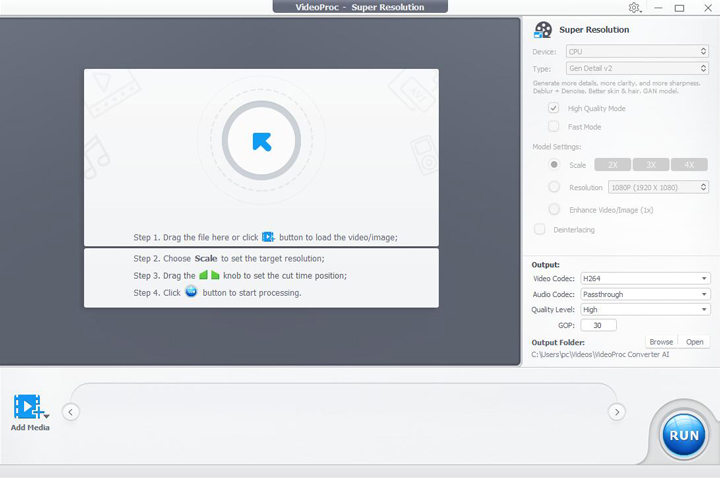
Step 3. Select the desired AI model to enhance your video:
- Gen Detail: generate more details, clarity, and sharpness for your videos, and deliver better quality.
- Real Smooth: tailored for video restoration, smoothing, flaw elimination, and enhanced fidelity.
- Anime: enhance and restore anime videos on older computers.
- Zyxt: enhance the resolution of low-quality video on older computers.
Tips:
- It is recommended to use the latest generative AI models (Gen Detail and Real Smooth) for the best enhancing results; if you are using an older computer, you can opt for the Anime or Zyxt models, which are designed to perform efficiently on less powerful hardware.
- Select between 'Fast Mode' or 'High Quality Mode' based on your preference for either improved processing speed or quality.
Step 4. Choose a scale option to enhance your video resolution by 2X, 3X, or 4X, or use the output resolution presets (1080p/2K/4K) directly to specify the output video size you want.

Step 5. (Optional) you can cut the video to enhance only a specific segment. Moreover, you can use the AI Frame interpolation and AI Stabilization features to further enhance your video quality.
Step 6. Hit the Run button to fix and make the video quality better using VideoProc Converter AI.
2. Topaz Video Enhance AI
Best AI video quality enhancer to restore old footage
Operating System: Windows, Mac
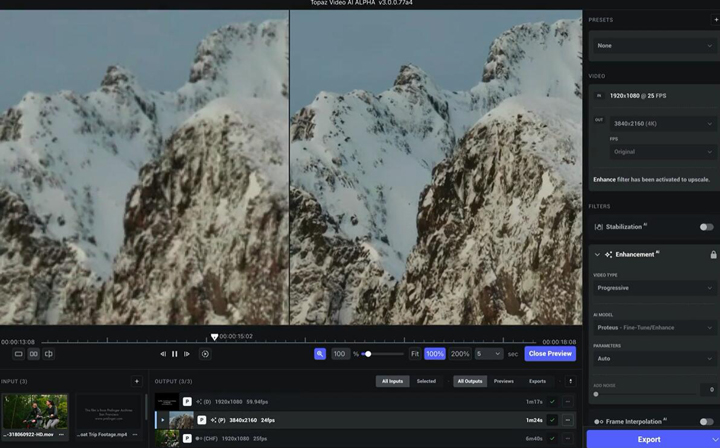
Topaz Video Enhance AI stands as a dedicated video quality enhancer desktop users could leverage to fix and enhance video quality. Powered by cutting-edge artificial intelligence technology, it goes beyond the traditional methods to rectify and amplify video quality, rendering visuals sharper and more intricately detailed. The software uses machine learning algorithms to analyze and identify the patterns in the video footage and then fills in the missing details by adding new pixels to the image. It also reduces noise and artifacts that may be present in the original footage, resulting in a cleaner and more polished final product.
Price: 30-Days Free Trial; $299 for unlimited one-year unlimited upgrades.
Pros:
- Enhance video quality up to 8K resolution.
- Adjust color and contrast, deinterlace footage, stabilize shaky footage, and remove motion blur.
Cons:
- Not very friendly for beginners.
- High price.
How to Enhance Video Quality with Topaz Video Enhance AI
Step 1. Download the video quality enhancer to your PC/Mac, run it and import your videos.
Step 2. Choose the AI processing models
Once the videos are imported, you need to select the ideal AI models for enhancement. The video enhancing software provides a diverse range of AI Processing models, each tailored to cater to specific video enhancement requirements.
Step 3. Adjust the output settings.
Apart from the presets for fixing and improving video quality, the video quality increaser also offers the option to craft custom settings for more personalized results. You can determine the output settings based on your requirements and preferences once you've decided on the AI models.
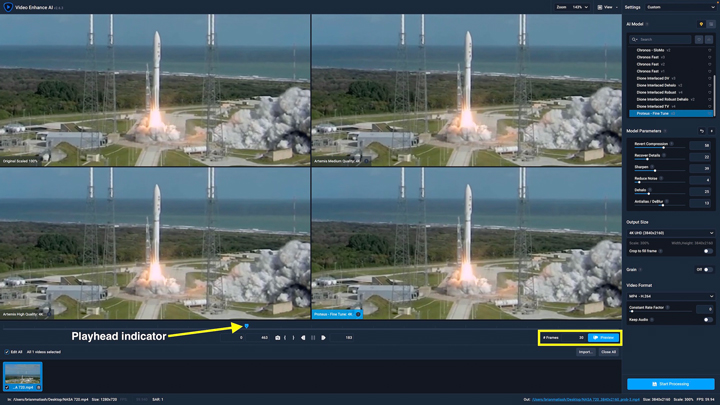
Step 4. Preview the output.
Before proceeding with the output, you have the option to generate a 30-frame rendered preview of your video, which can be a valuable checkpoint, allowing you to evaluate the enhancements and modifications applied to your video content before initiating the complete processing of the entire video enhancement.
Optional: you can opt to trim only the specific segment of the video you need to enhance, and to do that, just drag the slider along the timeline to designate the start and end timestamps.
Step 5. Click on Start Processing to enhance video quality and save the final output.
3. Adobe Premiere Pro
Best for the top professionals to enhance video quality
Operating System: Windows, Mac
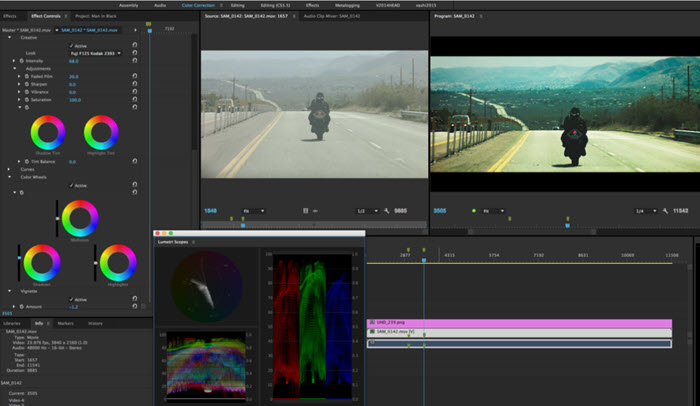
How to make video quality better? As one of the best video editing software and video quality enhancers for 1080P, Adobe Premiere Pro absolutely does the trick. The video enhancing software offers a variety of tools to fix and improve video quality, including the Unsharp Mask Effect. This effect allows you to sharpen and enhance blurry footage by fine-tuning parameters such as Amount, Radius, and Threshold. On top of that, the robust 4K video enhancer software can also help you boost contrast and clarity, fine-tune vibrance and saturation, adjust shadow tint, and even give your video a cinematic look reminiscent of a Hollywood film. With Adobe Premiere Pro, you can turn a low-quality video into a polished masterpiece.
Price: $20.99 per month
Pros:
- Easily fix low-quality videos and make bad quality videos better.
- Includes both mannual and AI features to enahnce video quality .
Cons:
- The plugin is required to increase video resolution.
- Not very friendly for beginners.
- The 'audio out of sync in Premiere' error occurs occasionally.
How to Enhance Video Quality with Adobe Premiere Pro
Step 1. Open Adobe Premiere Pro and go to "File" in the top left corner. Choose "Import" to add your video to the project, and drag your video from the Project panel to the Timeline.
Step 2. Click the "Adjustment Layer" icon on the right side and place it above your video on the Timeline. This will allow you to add effects to your video.
Step 3. To enhance video quality, first use the Razor tool (shortcut: C) to cut unnecessary parts of the Adjustment Layer if needed. Then click the Adjustment Layer with the FX icon, go to the "Effect" tab, and drag "Unsharp Mask" onto the Adjustment Layer in the Timeline. Adjust the sliders in the "Unsharp Mask" settings on the left to enhance video quality. You can also add masks to your video using the shape tools.
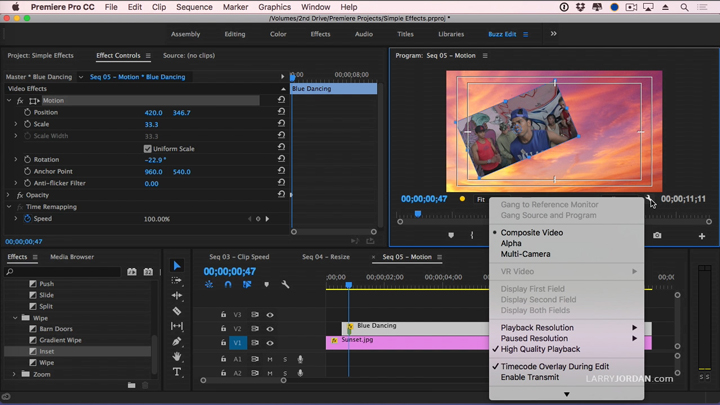
Step 4. Locate the Exports and customize the settings as per your preference. Then, click "Export" to enhance video quality.
4. After Effects
Best video quality enhancer to fix video colors and correct poor exposure.
Operating System: Windows 11/10 (64 bit), macOS 10.13 or later
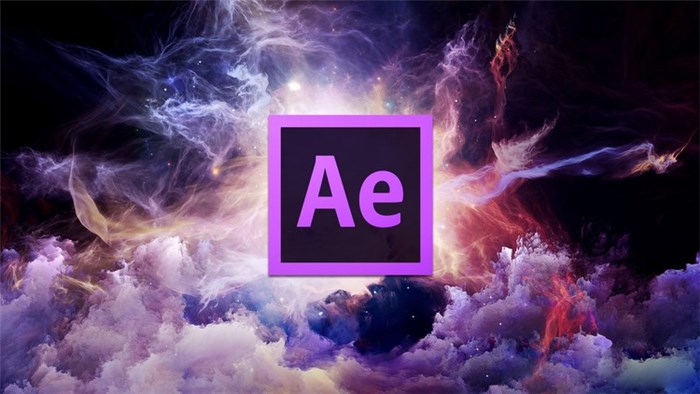
In addition to Premiere Pro CC, Adobe offers another tool for improving and fixing video quality: After Effects. While this video quality enhancer is primarily geared toward animation compositing, motion graphics, and visual effects (VFX), it also helps you fix video colors, remove grain, correct poor exposure and white balance issues, and stabilize shaky footage using the Warp Stabilizer VFX effect to increase video clarity. Whether you need to touch up a few rough spots or completely fix and enhance video quality, After Effects has you covered.
Price: $20.99/mo
Pros:
- Enhance video quality, adjust brightness and contrast, and correct poor exposure and white balance issues.
- It can fix grainy footage.
Cons:
- A Super Resolution plugin is required to fix and enhance low res videos.
- A steep learning curve is required, which turns some users to the After Effects alternatives.
How to Enhance Video Quality with After Effects
Step 1. Import your footage you wish to enhance the quality of to the After Effects
Open After Effects and import your video by dragging and dropping it from your computer to the program. Place the video on the Timeline by dragging it from the Library.
Step 2. Stabilize Shaky Footage
Select your video layer in the timeline. In the menu, go to Effect > Distort > Warp Stabilizer VFX. Adjust stabilization settings in the Warp Stabilizer VFX effect to reduce shakiness.
Step 3. Color correct your video to improve video quality.
In the menu, go to Effect > Color > Lumetri Color. Use the Lumetri Color effect to fine-tune aspects like exposure, contrast, highlights, shadows, and more under Basic Correction. You can also fix or enhance colors using White Balance.
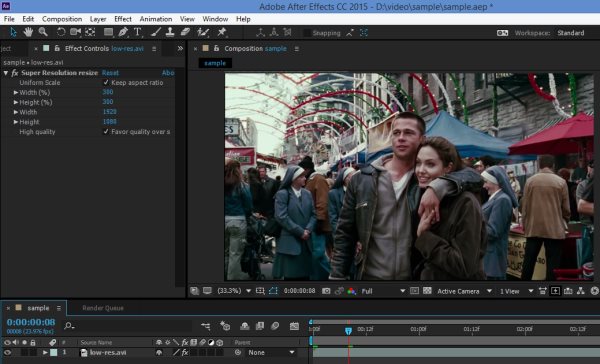
Step 4. Export to enhance your video quality
Tips: When exporting, choose H.264 or HEVC as the video codec to maximize final project quality.
5. Final Cut Pro X
Best video quality enhancer to fix flawed and low quality video files on Mac.
Operating System: macOS (64bit)
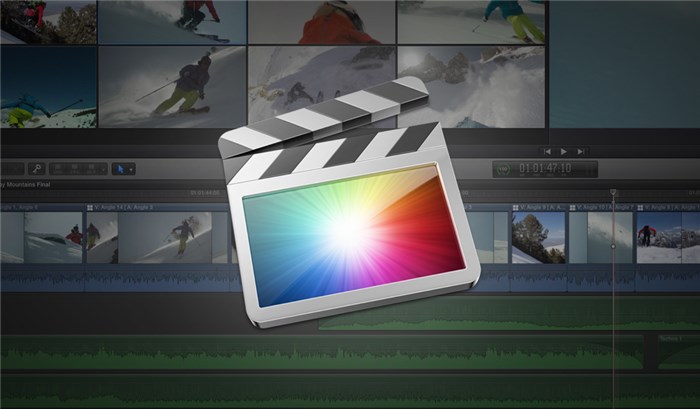
Final Cut Pro, developed by Apple Inc., is a top-tier color grading software and 4K/1080p video quality enhancer software. With its comprehensive suite of filters and correction tools, you can easily adjust brightness, white balance, and contrast, as well as fine-tune the gamma levels, apply sharpening or blurring effects, and add distorting effects such as fisheye, pond ripple, and whirlpool to fix and enhance video quality. Additionally, the video enhancement software offers LUTs and tint filters that allow you to completely transform the look and feel of your footage. Whether you're working on a professional production or a personal project, Final Cut Pro is an excellent choice for taking your video quality to the next level.
Price: $299.99 (one-time price)
Pros:
- It offers a non-linear timeline that let you fix and enhance flawed or low-quality video files easily.
- A good video quality enhancer for Mac users.
- It has much more features than iMovie.
Cons:
- There's no Final Cut Pro for Windows OS.
- It is very pricy.
How to Enhance Video Quality with Final Cut Pro X
Step 1. Import your clips to the video quality enhancer and place it on the Timeline.
Step 2. Select your footage on the timeline, and press Option + Command + B. In the Inspector, change the Balance Color setting from Automatic to White Balance.
Fine-Tune Exposure: Press Command + 6 to open the Color Board. Adjust the Exposure mid-tones and add blue or red to the highlights as needed.
Step 3. Press Command + 5 and navigate to Effects. Under Basics, find the Noise Reduction filter, and configure Noise Reduction, adjusting the Amount to High and Sharpness to Medium. This can greatly fix and improve video quality.
Tip: As the Noise Reduction effect is resource-intensive, you can improve the performance by dragging the Noise Reduction effect to the top of the effects list.
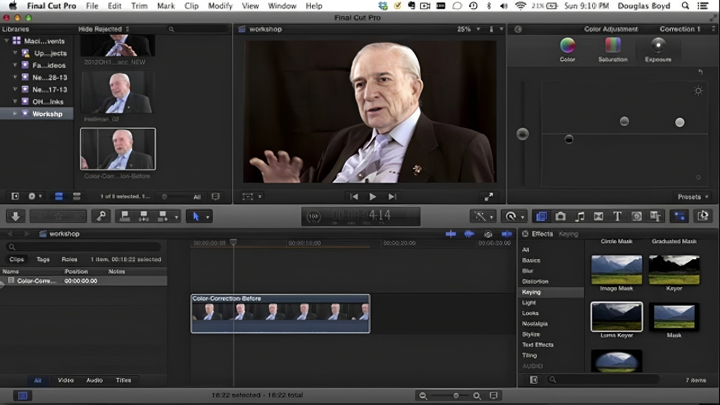
Step 4. Preview the result and export the project.
6. Blender
Best free video quality enhancer with 3D modeling and VFX capabilities.
Operating System: Windows, macOS, and Linux.
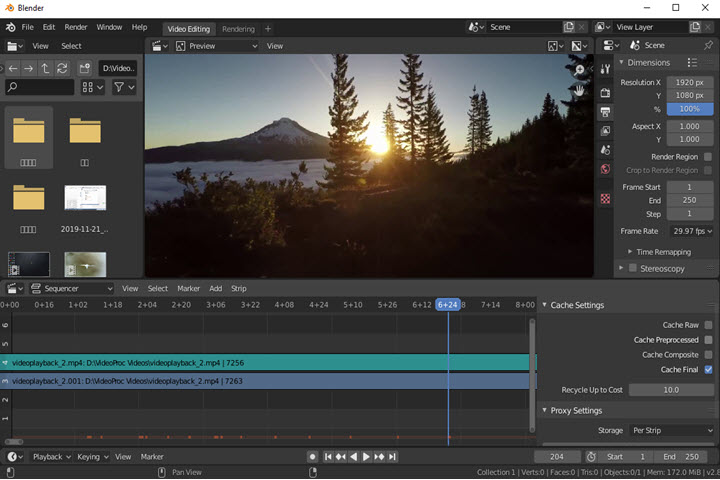
Blender is renowned for its 3D modeling and VFX capabilities, as well as its ability to enhance videos quality. With customizable render settings, you can improve your video quality by adjusting the encoding format from Xvid to H.264, increasing the bitrate settings and samples. Moreover, the free video quality enhancer's Color Management feature enables you to fine-tune your video's display device, video transform, contrast, gamma, and sequencing.
Price: free
Pros:
- It is free.
- It helps fix noises on the image when rendering.
- It can do with basic editing and advanced editing.
Cons:
- The wrong settings might decrease the image quality.
- It can be slow with both CPU and GPU.
How to Enhance Video Quality with Blender
Step 1. Import the footage you wish to enhance the quality of.
Open Blender and choose the "Video Editing" workspace, and import your video by clicking "Add" and selecting your file.
Step 2. Go to the Color workspace, add a color balance to adjust the colors.
Step 3. Improve sharpness with the "Sharpen" tool, and reduce noise using the "Denoise" tool.
Step 4. Export your video to enhance the video quality.
How to Enhance Video Quality Online
The online video quality enhancers are becoming increasingly popular, and most video quality increasers online are free and easy to use, enabling users to improve video resolution, perform basic color correction, and remove shaky footage and background noise to fix and improve the quality of video.
1. Fotor Video Enhancer
Best online video quality enhancer to improve video resolution
Fotor Video Enhancer is a cutting-edge online tool that uses AI to improve video quality effortlessly. It supports common formats and offers both automatic and customizable enhancements for aspects like sharpness, color, and brightness. This tool bridges the gap between advanced video enhancement and ease of use, offering a powerful solution for content creators who want professional-grade results without complex software.
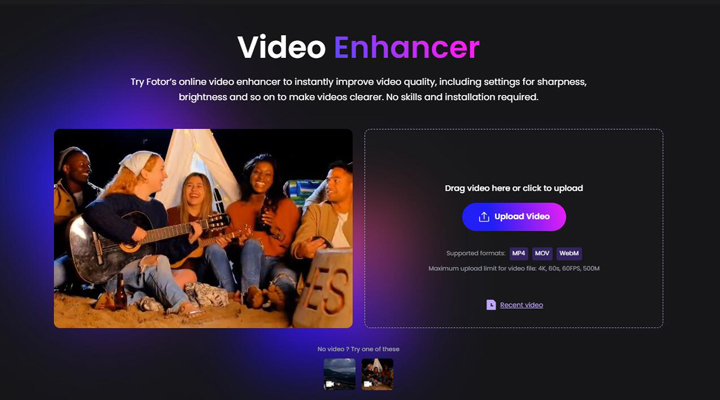
Price: Limited free version; 3.33/mo for Fotor Pro and $7.49/mo for Fotor Pro+
Pros:
- Easy to use and AI-powered enhancements.
- Customizable options for specific enhancements like sharpening details, color correction, and brightening dark videos.
- User-friendly interface and cross-device compatibility.
Cons:
- Potential for lower image quality and lossy compression.
- Limited free version.
How to Enhance Video Quality Online with Fotor Video Enhancer
Step 1. Go to Fotor's video enhancer page and upload your video. You can either drag and drop your video file or click to browse and select it.
Step 2. Once uploaded, Fotor's AI-powered video enhancer will automatically analyze and improve your video quality.
Step 3. While Fotor applies automatic improvements, you can customize specific aspects like sharpening details, color correction, and brightening dark areas if desired.
Step 4. Preview the enhanced video, and download the enhanced video once you are satisfied with the results.
2. Clideo
Best free 1080p video quality enhancer online
Clideo's online video enhancer tool can automatically enhance the video's quality by adjusting the brightness, contrast, and saturation levels. You can also manually adjust these settings if you prefer and make video quality better and clearer. Moreover, Clideo also offers other video editing tools that allow you to merge, cut, crop, rotate, loop videos, add subtitles, or make stop motion and slideshows, etc.
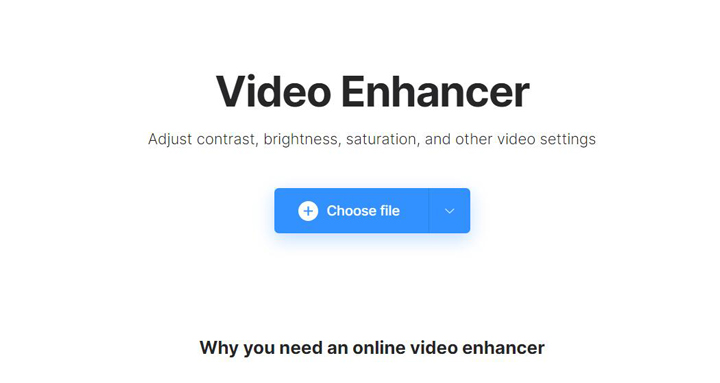
Price: free
Pros:
- A free way to enhance and improve video quality online.
Cons:
- Has limited features for video quality enhancement.
- Has a file size limit of 500 MB.
How to Enhnace Video Quality Online with Clideo
Step 1. Go to the Clideo's online video enhancer and upload your video file.
Step 2. Once uploaded, adjust the settings for brightness, contrast, sharpness, and color correction to adjust video quality.
Step 3. Preview the changes to ensure you're satisfied with the enhancements. When you're happy with the result, download the enhanced video.
How to Enhance Video Quality on iPhone/Android
For a mobile user, it would be nice to improve video quality on the iOS or Android device directly. There are some video enhancer apps do have a magic touch. Here we have found three useful tools for you to have a shot.
1. Pinnacle Studio
Best video quality enhancer app for iPhone users.
Operating System: iOS, Windows

Aimed at near-professional enthusiasts, Pinnacle features a range of video enhancement tools including color correction, brightness and contrast adjustment, etc. that can help improve the overall quality of your videos. Furthermore, the video quality increaser app also allows the ability to smooth out shaky footage, which is especially useful when working on footage shot on a handheld camera. But it's important to note that while Pinnacle can increase video quality, it can't completely fix poorly shot or low-quality video.
Price: Entry-level for $59.99, and Ultimate for $129.99
Pros:
- Clear interface with tons of effect.
- Support 3D editing and detailed masking tools.
- Color correction, brightness adjustments, and video stabilization to improve the overall quality of your video
Cons:
- Price is a little too high.
- Lack Android mobile version.
How to Enhance Video Quality on Mobile with Pinnacle Studio
Step 1. Install and open Pinnacle Studio on your phone. Start a new project and import your video.
Step 2. Work on the options to fix the video quality:
- Use the "Corrections" tool to adjust brightness, contrast, and color.
- Adjust video resolution in the "Properties" section if needed.
- Cut unwanted sections using the scissors tool.
- Add music or sound effects to enhance audio quality.
Step 3. Preview your edits and make adjustments as necessary. When satisfied, export the video at the highest resolution available.
2. GoPro Quik
Best video quality enhancer app to auto-correct color and lighting.
Operating System: iOS, Android

Available on App Store or Google Play, Quik allows users to quickly and easily fix and enhance the quality of their videos. Its video enhancement tools include features such as auto-correct for color and lighting, stabilization to reduce camera shake, and filters and effects to add creative flair to your videos. Additionally, the video quality enhancer app uses algorithms to analyze your footage and identify the best moments to highlight, and can automatically create an edited video montage for you in just a few clicks.
Note: Quik was discontinued and has moved to Legacy software of GoPro.
Price: free, Premium Monthly for $1.99, Premium Yearly for $9.99
Pros:
- Very friendly for GoPro HERO 5 to HERO 7 users.
- It has some intelligent features like detects faces, choose the great moment and detects voices.
- Support HD 1080p 60fps.
Cons:
- GoPro quik is discontinued.
- It is old and does not support new features of GoPro HERO 8.
- It has in-app purchases for subscription.
- It does not change video resolution, stabilize shaky videos or remove noises.
- It doesn't support full 360°.
How to Enhance Video Quality on Mobile with GoPro Quik
Step 1. Import your GoPro footage into the Quik app by connecting your camera or SD card to your device, and select the video clips you want to enhance in the app's media library.
Step 2. Open the selected clips in Create mode, and use the options provided to improve the quality of your video:
- Use the "Corrections" tool to adjust brightness, contrast, and color of your video.
- Trim unwanted sections of your clips by double-clicking on a clip and dragging the blue brackets to adjust the start and end points.
- Apply filters or effects to enhance the visual quality. Quik offers various preset themes and filters.
- Adjust the video resolution if needed. Higher resolution generally means better quality.
- Add music to complement your video. Quik can automatically sync your clips to the beat of the music.
Step 3. Preview your edits and make any final adjustments as necessary. When satisfied with the enhancements, export your video for the best quality.
3. Videoshop
Best free video quality enhancer app with various video editing features
Operating System: iOS, Android.
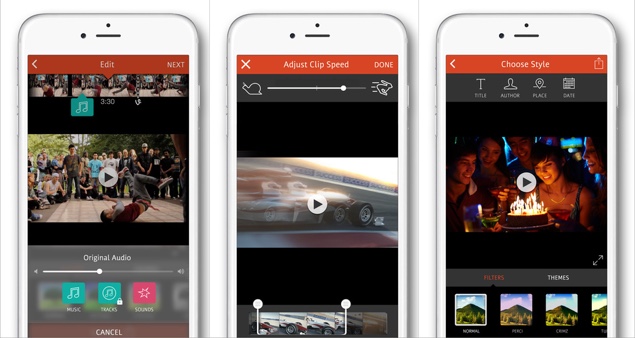
Videoshop offers virtually all the basic video editing features you'll need, including trimming, merging, rescaling, adding music or sound effect, recording voiceover and adjusting speed. It enhances your video quality mainly by adding filters and effects. Specifically, the video enhnacer app has Instagram-inspired filters and 10 transitions. You can also polish your videos like a pro by using its advanced features like split-screen, picture in picture, green screen, motion track, keyframing, advanced color tuning, audio detaching, scene detection, stabilize video, etc.
Price: free
Pros:
- It allows you to share videos to Vimeo, Instagram, YouTube, Facebook, Email and more.
- You can set resolutions and frame rates to customize your video quality.
Cons:
- Editing videos from some devices other than Windows Phone are likely to crash and go unstable.
- Not friendly to large video processing.
How to Enhance Video Quality on Mobile with Videoshop
Step 1. Install and open Videoshop on your mobile device. Import the video you want to enhance by tapping the "+" button.
Step 2. Improvide the video quality with options provided::
- Use the "Corrections" tool to adjust brightness, contrast, and color saturation.
- Apply filters to improve the overall look of your video.
- Use the "Trim" feature to cut out any unwanted sections.
- Adjust video speed if needed to enhance certain parts.
- Use the "Voice" feature to add voiceovers or adjust audio quality.
- Preview your edits and make any final adjustments.
Step 3. When satisfied, export your video.
Note: Mobile apps and online solutions for video enhancement, while convenient, generally offer limited capabilities compared to AI-powered software. For significant video quality improvements, it's highly recommended to use the advanced AI video upscaling software mentioned earlier in this post on a computer.
Best Video Quality Enhancer Comparison Chart
| Video Quality Enhancer | Best for | Ratings | Platform |
|---|---|---|---|
Overall best AI video quality enhancer to enhance video quality |
Windows/Mac |
||
Enhance and improve old video quality using AI |
Windows/Mac |
||
Skilled users to fix old quality videos |
Windows/Mac |
||
Correct video colors and fix video quality |
Windows/Mac |
||
Make bad quality videos better on Mac |
Mac |
||
Free video quality enhancer with 3D modeling |
Windows/Mac/Linux |
||
Enhance and improve old videos quality online |
Online |
||
Free 1080p video quality enhancer online to improve video quality |
Online |
||
Enhance video quality on iOS devices |
iOS/Windows |
||
Fix and improve video quality captured using a GoPro camera |
iOS/Android |
||
Free video quality enhancer app with many editing features |
iOS/Android |
Pre-Production Tips for Better Video Quality
Apart from the video quality enhancers you can use to fix video quality, here are some effective methods to improve video quality:
- Use a High-Quality Camera: Start with the best camera you can afford. Higher resolution (like 4K) provides better quality and allows for cropping without losing detail.
- Adjust Lighting: Good lighting is crucial. Use natural light or invest in softbox lights to eliminate shadows and enhance clarity.
- Stabilize Your Footage: Use a tripod or gimbal to avoid shaky footage. Many editing software also offer stabilization features.
- Check Your Framing: Pay attention to the composition of each shot. Use the rule of thirds to create visually appealing scenes and avoid cluttered backgrounds.
- Adjust Camera Settings: Use manual settings for better control. Set the appropriate frame rate (e.g., 24fps for a cinematic look) and adjust ISO, aperture, and shutter speed to match the lighting conditions.
- Shoot in a Controlled Environment: Minimize background noise and distractions. Choose quiet locations and time your shoots when there are fewer interruptions.
- Record Extra Footage: Capture more footage than you think you’ll need. B-roll can be invaluable during editing and helps create a more dynamic video.
Post-Production Tips to Fix Video Quality
Fixing video quality involves a combination of techniques, depending on the specific issues you're facing. Here's a breakdown of common problems and their solutions.
Frustrated with these multi-step adjustment? Discover a one-click solution to effortlessly fix and enhance your video quality.

1. Upscaling for Enhanced Resolution and Clarity
One of the most effective ways to combat poor video quality, especially when dealing with low resolution footage, is through upscaling. This process involves using specialized software or online tools, often powered by artificial intelligence, to increase the pixel count of your video. AI algorithms analyze the existing frames and intelligently generate new pixels, effectively enhancing clarity and sharpness. This is particularly useful for older videos or footage shot with lower-resolution cameras, allowing you to view them on larger screens without significant pixelation.
2. Sharpening and Noise Reduction for Refinement
For noticeably better video quality, sharpening and noise reduction are essential. Sharpening refines edges for clarity, while noise reduction smooths out grain, especially in low-light situations. The careful application of both techniques results in a cleaner, more professional-looking video.
3. Color Correction and Lighting Adjustments for Visual Appeal
Color correction significantly improves video visuals. Adjusting brightness, contrast, and saturation fixes imbalances and adds vibrancy. While re-shooting with better lighting is ideal, post-production adjustments can salvage footage. Advanced color grading allows for creative control, transforming dull videos into captivating ones.
4. Video Stabilization for Smooth Playback
Shaky footage can be distracting and detract from the overall viewing experience. Video stabilization tools address this issue by smoothing out unwanted camera movements. These tools analyze the video for motion patterns and apply algorithms to counteract the shakiness, resulting in a more stable and professional-looking video.
5. Re-encoding and Compression Management for Optimal Output
Compression artifacts, which appear as blockiness or blurriness, are a common problem when dealing with compressed video files. Re-encoding your video with a higher bitrate can help mitigate these artifacts by preserving more visual detail. When exporting your videos, it's crucial to choose appropriate codecs and export settings to minimize quality loss.
Using a file type that employs less compression, or selecting a higher quality compression setting, can significantly improve the final output. This attention to detail during the encoding process ensures that your videos maintain their clarity and sharpness, even after being compressed for storage or online distribution.
6. Playback Optimization for Seamless Viewing
Even with high-quality video files, playback issues can arise due to incompatible codecs, outdated software, or slow internet connections. Ensuring that your playback device and software support the video's codec is essential for smooth viewing. Regularly updating your video drivers and software can also address compatibility issues.
For online streaming, a stable and fast internet connection is crucial to avoid buffering and reduced video quality. Adjusting the video quality settings on the streaming platform can also help optimize playback based on your internet speed. Additionally, enabling hardware acceleration in your video playback software can improve performance and ensure a seamless viewing experience.
FAQ
1. What are the common video quality related issues?
Video quality issues can throw a wrench into your viewing experience. Here are some common culprits:
- Low Resolution: When videos lack the sharpness and clarity expected, resulting in a pixelated or blurry display.
- Compression Artifacts: These occur when video files are compressed, leading to visible distortions like blocky or fuzzy elements.
- Frame Rate Issues: Videos with inconsistent or low frame rates can cause stuttering or choppy playback.
- Color Distortion: Problems with color accuracy, saturation, or contrast can affect the overall visual appeal.
- Interlacing: An outdated issue where the lines between two consecutive frames are visible, causing a comb-like pattern.
- Noise and Grain: Unwanted visual disturbances, like static or graininess, can degrade video quality.
- Aspect Ratio Problems: When the proportions of the video are not maintained, leading to a distorted display.
2. How does AI video enhancement differ from traditional enhancement methods?
Unlike traditional methods that apply fixed filters uniformly across frames, AI-powered enhancement employs neural networks (like Convolutional Neural Networks5) to analyze contextual patterns in your footage. This adaptive intelligence allows three key distinctions:
- Cognitive Restoration: AI reconstructs missing details by referencing millions of learned video patterns14, while traditional upscaling simply stretches pixels.
- Dynamic Processing: AI models adjust enhancement parameters frame-by-frame based on scene content13, versus static adjustments in legacy software.
- Cost-Efficiency: Modern AI tools achieve Hollywood-grade results in minutes through automated workflows2, eliminating intensive manual color grading.
3. What is the best way to enhance video quality?
If you are seeking a desktop solution, check out VideoProc Converter AI, the best AI video quality enhancer for Windows/Mac to fix and improve video quality; if you are looking for an online video quality enhancer, try Fotor Video Enhancer. Meanwhile, mobile users can rely on Videoshop as a dependable option to fix and enhance video quality.














